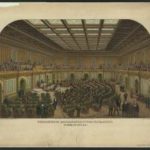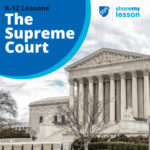From the colonial era, relations between European settlers and Native American nations have been complicated. In 1803 Congress authorized and funded an expedition led by Meriwether Lewis and William Clark for exploration of the region and for better knowledge about American Indians of the Northwest in order to develop trade. About 30 years later, the United States forced the removal of Native Americans from their lands to make way for white American settlement. Congress and the president made treaties with Native American nations, but those treaties were not always respected as the United States continued to expand into the west. After Native Americans enlisted and served in both World War I and World War II, Congress passed legislation to begin to address longstanding Native Americans claims against the United States Government.
Congress Investigates – Virtual Exhibit
The power to investigate, implied by the U.S. Constitution, is one of Congress’s most important tools for developing effective public policy, conducting oversight, and informing the public. Congress has investigated issues throughout its history via formal investigations and fact-finding inquiries with wide-ranging results, often significantly affecting the history of the United States.
The Equal Rights Amendment (ERA)
The Equal Rights Amendment (ERA) stated, “Equality of Rights under the law shall not be denied or abridged by the United States or any state on account of sex.” This proposed amendment was passed by Congress in 1972 but failed to be ratified by three-fourths of the states. This lesson provides an overview of the proposed amendment, arguments for and against ratification and possible future steps toward ratification. This lesson can be used in a traditional or flipped classroom.
House and Senate: What’s the Difference?
The United States Congress consists of two legislative bodies, the House of Representatives and the Senate. There are many similarities between these institutions. Representatives and Senators are directly elected by the public (see Capitol Visitor Center essay “Who Elects Our Senators?”). Passing legislation requires the agreement of both the House and Senate. There are chambers for both in the U.S. Capitol. Given these commonalities, are there really differences between the House and Senate?
The U.S. Constitution: Continuity and Change in the Governing of the United States

This unit examines continuity and change in the governing of the United States. Lessons one and two are focused on a study of the Constitution and Bill of Rights and provide access to primary source documents from the Library of Congress. Lesson three investigates important issues which confronted the first Congress and has students examine current congressional debate over similar issues. Lesson four features broadsides from the Continental Congress.
How Your State Gets Its Seats – Congressional Apportionment
The United States Senate consists of how many members? The answer is fairly simple: with two members apiece representing each of the fifty states, the total is one hundred. How about the House of Representatives? The answer is much more complicated. There are currently 435 voting members of the House of Representatives. How did this number come about and how is the number of Representatives per state determined?
LGBTQ Activism and Contributions Primary Source Set
The lives, freedom struggles, and social and cultural contributions of lesbian, gay, bisexual, transgender, and queer (LGBTQ) people make up a rich part of the history of the United States, and primary sources from the Library of Congress provide valuable opportunities to explore individuals, movements, and events from the nation’s LGBTQ history.
The Supreme Court: Balancing the Branches

The nine, lifetime-appointed justices on the Supreme Court play a huge role in our lives through interpreting the application of laws passed by the United States Congress and state legislatures. The Share My Lesson team has curated a collection of free lesson plans and activities to support teachers in educating their students about the structure and role of the Supreme Court.
Who Elects Our Senators
United States senators have been elected directly by voters since 1913. Prior to that time, state legislatures chose the state’s senators. In the mid-1850s, however, the state legislature selection process began to fail due to political infighting and corruption. Often Senate seats were left vacant for long periods of time while state legislatures debated who to send to the Senate.
Civil Rights
While the Reconstruction Amendments were an important step in ensuring equal rights for all people, regardless of race, racial injustices throughout the United States continued into the late 19th and 20th centuries, leading to the Civil Rights movement of the 1960s, and the passages of Supreme Court decisions and legislation, including Brown v. Board of Education, the Civil Rights Act of 1964, and the Voting Rights Act of 1965. Visit the National Constitution Center’s learning module to learn more about the freedom struggle and civil rights.